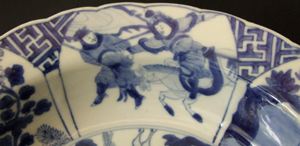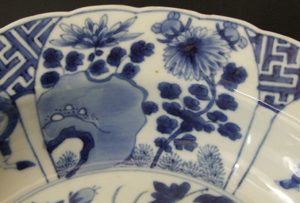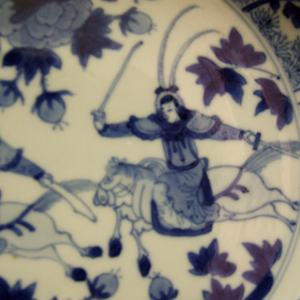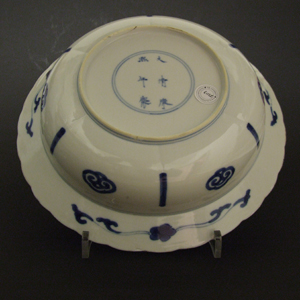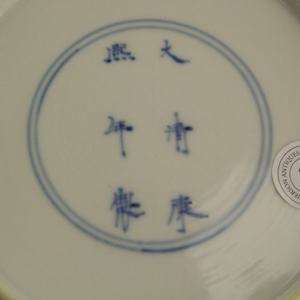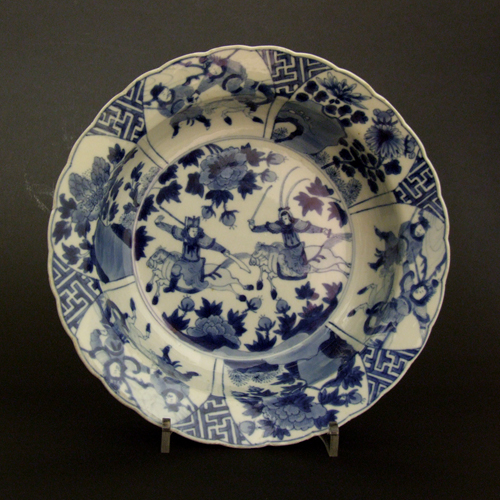
KANGXI 1662 – 1722 Chinese Export Porcelain
A Kanxgi Blue and White Porcelain Klapmutsen Type Dish. A None-Imperial Kangxi Six Character Mark and of the Period (1662-1722) Painted in Typical Rich Tones of Cobalt Blue the Central Scene Shows Armour Clad Soldiers on Horseback with Swords at the Ready Galloping Through Peony. The Border is of Bannermen and other Armed Men with Further Peony.
SOLD
- Condition
- Good, a small shallow chip to the back of the rim, a small amount of light polishing, light fritting.
- Size
- Diameter : 24.2 cm (9 1/2 inches)
- Provenance
- From an Old Cornish Collection of Chinese Porcelain.
- Stock number
- 23119
- References
- A larger dish of a related central design was sold at Christie`s London, 18th June 2002, lot 296, where it is also catalogued as a scene from Xixiang Ji. For a pair of Kangxi Mark and Period Porcelain dishes of this size and design see ; Fine Chinese Ceramics and Works of Art, Sotheby`s New York, March 30th 2006. For a similar but larger Kangxi Blue and White Porcelain dish of this pattern see : Seventeenth-Century Blue and White Porcelain and Copper-Red and Their Predecessors (Exhibition Catalogue, S Marchant & Son, London,June 1997) Item 65 Page 69. For a larger Kangxi blue and white porcelain dish of this type see : Chinese Porcelain in the Collection of the Rijksmuseum Amsterdam, The Ming and Qing Dynasties (Christiaan Jorg, Phillip Wilson, The Rijksmuseum, 1997) page 94, plate 82. For a further Kangxi blue and white porcelain dish of this pattern see our `Sold Items` number 20053.
Information
Kangxi Battle Scene :
The scene is possibly taken from part three of Xixiang Ji, The Romance of the Western Chamber, in which General Du routes Sun and is attacking the Temple of Pujiu. A related scene is depicted on one of a set of eight Kesi (woven silk) banners included in the exhibition `Weaving China`s Past ; The Amy S. Clague Collection of Chinese Textiles, Pheonix Art Museum, Phoenix, Arizona, 2000, cat. no 15, where the author identifies it as an episode from the Yuan drama Xixiang Ji (The Romance of the Western Chamber). Battle scenes from Sanguo Zhi Yanyi (Romance of the Three Kingdoms), the famous Yuan dynasty historical novel, were more frequently used as decoration on Kangxi porcelain so it is maybe more likely that the present scene is from Sanguo Zhi Yanyi. However, Regina Krahl and Clarrissa von Spee in Chinese Ceramics from the Gulexuan Collection Lunen, 2003, p132, note that the battle scenes play a minor part in that love story and raise the possibility that it may not be of this literary source.
None-Imperial Kangxi Marks :
Despite having a six character Kangxi mark this piece is not imperial, indeed it was not even made for the Chinese market. This is a Chinese export porcelain dish that was made for the European market, possibly for the Dutch. In earlier periods a six character reign mark would not have been allowed on none imperial porcelain, but Kangxi export porcelain does occur with the six character mark of Kangxi quite regularly. However, the marks from previous emperors occur far more frequently on Kangxi porcelain, especially that of the Ming emperor Chenghua 1465-1487. It is interesting to note that 19th century copies of Kangxi porcelain often use a four character Kangxi mark rather than the standard six character mark. Four character Kangxi marks are hardly ever found on genuine Kangxi porcelain.
Klapmutsen, Bowls and Dishes :
Klapmutsen bowls with high or low sides were a favourite of the Dutch during the first half of the seventeenth century. A shallow Kraak porcelain Klapmutsen was ideal for stews and soups, a western pewter spoon could rest on the edge without falling in. V.O.C. records show that Klapmutsen were ordered in four different sizes. Versions of the form persist into the Kangxi period (1662-1722) although the shape had by then become more to do with esthetics and tradition than function.
